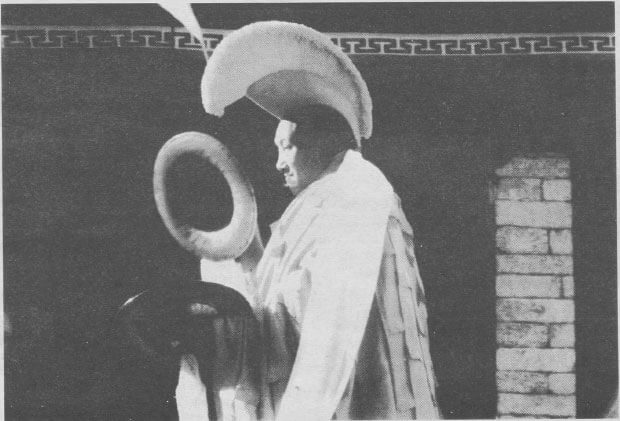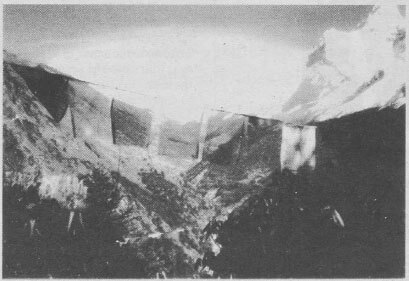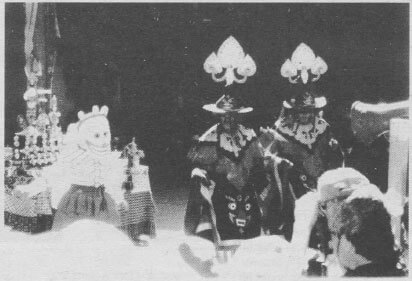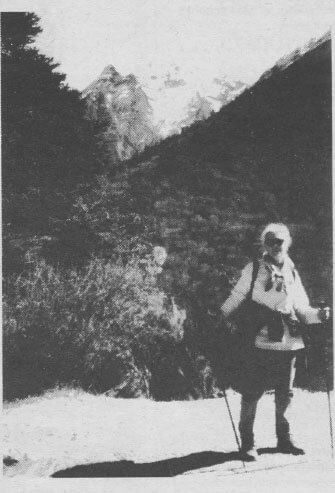| The following article is from the Summer, 1998 issue of the Snow Lion Newsletter and is for historical reference only. You can see this in context of the original newsletter here. |
Lama cymbalist at Thengboche Monastery during the second day of the Mani Rimdu Festival.
by June Calender

We've signed up another woman who's never slept in a tent either, said Youden, the cheerful Nepali woman at Snow Lion Expeditions. That tipped the balance of my internal debate about signing up for the trek. Mountain climbing is for more daring, much younger men and women, but I'd developed a serious longing to be among the Himalayas. I flew over them on two round trips from Kathmandu to Lhasa and felt the urge to jump out of the airplane and walk the flanks of the giants.
My birthdays edge toward the big 6-0 and a small voice urged, Do the things you want now...while you still can. I was inspired by Alexandra David-Neel, who in 1924, at age 55, on foot, disguised as a poor pilgrim with only a young lama companion became the first European woman to enter then forbidden Lhasa. I bought some trekking poles and hiking boots, added push ups to my yoga routine, walked farther and faster than usual and began taking the stairs to my seventh floor apartment.
In November I saw the Himalayas again from the air but at very close range as a helicopter headed for the postage stamp-sized field at Lukla, a town that can only be reached by air or by foot.
A dozen Sherpas joined our small group. The first afternoon's hiking was mostly downhill my kind of hiking! The -villages were small and full of lodges, with vegetable gardens where brightly plumed chickens scratched for bugs. Then we came to a foot bridge suspended above a torrent roaring over a boulder-strewn bed 20 feet below. My first real test: would I have a fit of vertigo and freeze midspan? I stepped out cautiously and held tight to the guide wires. At the other end I was grinning like a teenage getting off a rollercoaster. WOW!! WHAT FUN!
The Sherpas had set up our camp in a field beside the river. I crawled inside a tent for the first time. Jeez Louise! The entire space was smaller than a king-sized bed. Two duffles and two mats on which to unroll sleeping bags left about an inch between my tent-mate's side and mine. She was still on the trail. Could I squelch my claustrophobia as easily as vertigo?
Dusk was falling. No light, I'd better get my contact lenses off. Oh-oh! The right one popped out and disappeared. I searched my lap, my clothes, the open cosmetic case. No luck. Okay, take the left one off, put on glasses, get a flash light. Damn! The left lens disappeared too. Rotten luck. My tent mate arrived exhausted but helped me search. No good. They were gone. GONE! I had my glasses but my new Raybans were not prescription. Would the brilliant mountain light contribute to early macular degeneration?
At dinner in the mess tent, I assessed the group. My roommate was a few years younger than I, and in a sense, pooping out. The California contingent was four yoga devotees, all were 40-something. Two couples completed the group, a -50-ish athletic woman, lean and hard, with her equally fit significant other and Gerda, a hardy retiree who hiked with her very fit husband. Steve, our guide, was younger than any of us.
In the morning my roommate moved to a lodge where, until we returned, she would get to know local people and explore the environs. We hiked beside the river until lunch. The pre-trek outline has said this would be the hardest day but hey! It was a lark so far.
After lunch we crossed another bridge and began a 2000 foot climb. We entered Sagarmartha National Park. In Nepali, Sagarmatha is Everest, while park is apolitical status and does not imply tended trails, comfort stations or picnic tables. At over 9500 feet the oxygen was about 35% less that sea level. Breathing was difficult. The trail zigzagged, up and up and up and up.
Gerda, Valerie, Diane and I drifted more and more to the rear. We hoped for yak bells. Sherpas driving loaded yaks deserved the right of way. Trekkers step aside and rest as they pass. Steve had advised, Take your time. Rest as much as you need to. We rested every ten minutes, then every five minutes, then every twenty steps, then every ten steps. The two Sherpas shepherding us offered to carry our day packs. My first brave no thanks soon turned into a grateful Oh, thanks so much.
That afternoon was the longest and hardest time of my life, bar none harder than shoveling a driveway after a three-foot blizzard, worse than walking a colicky baby all night, ever worse than a tortured weekend before a root canal. Geologists say the Himalayas are still growing, that one stretched taller at every zig and zag in the trail. I didn't want to admit that I was too over the hill to climb up this one. I thought of the women in my family dead of heart disease. I thought of the children's story about the little engine that said, I think I can, I think I can....
Namche Bazaar sits in bowl surrounded by snow peaks which were magical in a golden sunset light beneath a celestial blue sky. If I had had any breath left, it would have been breath-taking. At dinner even the athletic hares wore the look of stunned exhaustion I could feel on my face. The plain hearty meal was incredibly delicious, but no one lingered after tea in the warm lodge.
After ten hours of dead-to-the-world sleep I heard the cook, a tent or two away, calling Bed tea! The opaque tent was filled with a warm sand color light but my washcloth was frozen stiff. 1 roused myself on an elbow and noticed a sparkle on the floor beside my sleeping mat. What, a contact lens? I learned later that the efficient Sherpas used a number system to match tents and luggage. Though taken down, carried up the mountain, and set up again, this was the same tent.

Prayer flags across Everest and Ana Dablon behind Thengboche Monastery.

Costumed lamas at the Mani Rimdu Festival at Thengboche Monastery.

The author on trail from Thengboche to Namchee.
Bed tea is a luxurious trekking ritual, soon followed by steaming washing water. When I pulled my toothpaste out of the cosmetic bag, VOILA! The other contact lens was stuck to the tube. My sea level brain admonished, Don't be superstitious, it's all coincidence. But my mountain brain said, You are blessed, or at the very least, in synch with the world. When I crawled out of the tent I saw, as I had not the night before, a small chorten 50 feet away. The Buddha eyes were in fading paint but they were looking at me. I said the Tibetan mantra, Om mani padme hum. Alexandra David-Neel wrote of magic and mystery in Tibet on the north side of the Himalayas, and I had found them here on the south side in Nepal.
The frosted grass at my feet sparkled, the encircling mountains were new-snow white against a sky as clean as the first creation. Walking to breakfast I noted no stiffness, no aches or pains from yesterday's exertions. Laughter rippled from the Californian's tents. This is the best of all possible worlds!
While the hares took a day hike to a higher town, four tired tortoises explored Namchee and its museum of Sherpa culture on a hill above our campsite.
Steve said the rest of the trek would be easier. After the day of rest, we were ready to go on to our major goal, Thengboche monastery where we would see the Mani Rimdu festival. It wasn't easy, in fact, when the trail plunged toward a river valley, I hated every easy downhill step because it meant I'd have to regain the distance, plus more. But I knew I would do it.
Among the city of tents in the field in front of the monastery, only ours had been sited so that, on opening the flap, the grand south face of Everest was directly ahead. Who needs to climb those dangerous ridges? This was the ideal place to contemplate the power of plate-tectonics, the magnitude of these mountains, valleys, glaciers and small self among them for such a brief moment in time. I was exactly where I had wanted to be when I had looked down from the airplane.
For the two-day festival Sherpas from all over the area crowded into the monastery courtyard with the tourists. We watched magnificently costumed lamas dancing, blowing jeweled oboes and twelve-foot long horns and clashing cymbals. At night, when the tourists went to the lodges for beers or to their tents to try to sleep, the Sherpas took over the monastery courtyard. Under the full moon, they sang folk songs, danced and drank chang (their beer). They celebrated until nearly dawn when they put their children on their shoulders and followed dark paths around the mountains to their villages. The harvest was being gatheredautumnal celebrations are even older than Buddhism. The next day, as we returned to Namche, bits of the Sherpa songs rang through the mountains as the celebration continued in their hearts and ours.
Early in the morning we left Tengboche. Gerda had a small, but scary, fall and Steve found two doctors who diagnosed a possible stroke. Two sturdy young Sherpas took turns carrying her piggyback to Namche to be flown to Kathmandu. There but for the love of God....
I wanted to memorize the return, every precious minute, whether gasping for breath, struggling uphill, or sipping hot Tang at lunch.
I had found my walking rhythm and now used my trekking poles like four-wheel drive for my feet (as the ad copy had promised). I paced myself between the hares and the tortoises, alone so I could contemplate the grey-blue-lavender of receding rows of mountains, listen to crows their picture, they would become dreadfully serious. The children I knew were hard working, cheerful and smiled a lot. What to do? Give them the camera of course. The pictures are terrific. I had the prints enlarged and sent them back to them and their parents.
The children were back and forth to the lodge across the trail. It turned out that two sisters had married two brothers, the one across the way had no children and this was her second marriage. She clearly enjoyed her nieces and nephew. Apparently, if you aren't happy in a Sherpa marriage, it is pretty easy to put an end to it and go on with someone elseand no hard feelings.
Then suddenly the group was claim their trees, delight in the tinkle of yak bells for their music, not as an excuse to rest. I marveled how those lumbering, heavily loaded animals confidently maneuver rocky assents and descents. I admired Sherpa porters shod in cheap Chinese-made sneakers or flip-flops carrying astonishing loads. I met a three-generation Tibetan family from the other side of Everest. They would walk two weeks to visit a revered lama who had fled Tibet and lives in Nepal and then trek back home. Long pilgrimages are a Tibetan custom that confers merit. For me, the reward and joy of the trek is that, while lack of oxygen may account for occasional euphoria, my feet trod the ancient, unyielding, sole-punishing mountain rocks.
In the helicopter, I watched the mountains recede and remembered a new motherhood moment: during labor I moaned never again but the first time my little daughter smiled at me, I thought it would be wonderful to have another baby. And I did. Will I return to the Himalayas? I hope so.
 June Calender is a professional writer living in New York City. Over a dozen of her plays have been produced in New York and other cities throughout the United States. Currently working on a based on fact novel, she has also published poetry in literary journals and nonfiction in national and regional publications.
June Calender is a professional writer living in New York City. Over a dozen of her plays have been produced in New York and other cities throughout the United States. Currently working on a based on fact novel, she has also published poetry in literary journals and nonfiction in national and regional publications.

